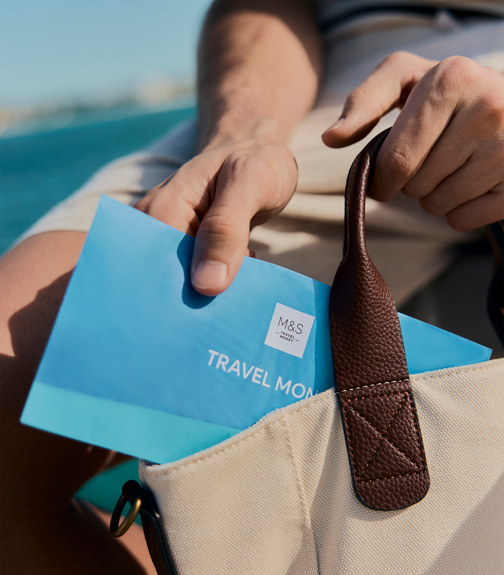-
Our Christmas opening hours may vary - please check your local branch hours before you visit.
How to buy Chilean Pesos
-
Buy Chilean Peso Online
Buy Chilean Peso online with Click & Collect at over 580 M&S stores. Use our Pounds to Chilean Peso (GBP to CLP) currency calculator to work out how many Chilean Peso you want. Pick your collection date and collect from your chosen M&S store.
Click & Collect Chilean Peso (CLP) in as little as 60 seconds.*
*Subject to availability
-
Buy Chilean Peso In-store
Buy Chilean Peso in your local participating M&S store.* With over 90 Travel Money Bureaux nationwide - many open seven days a week. - you can buy Chilean Peso at a time that suits you.
*In-store rates may differ from online rates.

Why buy Chilean Pesos from M&S Travel Money?
Planning an adventure to Chile? Make your Chilean Pesos stretch further with M&S Travel Money, the quick and easy way to get travel-ready.
- Our Chilean Peso rate has no hidden fees & zero commission
- Click & Collect Chilean Peso the same day*
- Stores open 7 days a week**
- Get more with Sparks Preferential Rates
**store opening hours vary

What you need to know about the Chilean Peso currency
The Chilean Peso is the official and legal tender of Chile. Its currency code is CLP and its symbol is $.
Chilean Pesos come in both coins and banknotes.
Coins include:
$10, $50, $100, $500
Banknotes include:
$1000, $2000, $5000, $10,000, $20,000
You can buy Chilean Pesos online using our click & collect service.
Please note not all denominations are available to exchange.

Guide to Chile
Chile is a unique place to visit, stretching over 4,200 kilometres with diverse landscapes and climates, from the red sands of the Atacama Desert to Patagonia's ice fields. This land of contrasts offers travellers a trip of a lifetime, especially if trekking and nature are your thing.
Santiago, Chile's capital city, is where modernity and tradition come together to create a unique atmosphere. There are also many nearby wine regions for those who enjoy a tipple or two. If adventure is what you seek, the Andes Mountains are the go-to destination for thrill-seekers and offer opportunities for skiing and mountaineering.
Frequently asked questions
You can use debit and credit cards in Chile’s urban areas and tourist spots. However, in more remote areas you'll likely need to use Chilean Pesos, which also helps you avoid the fees, charges and unfavourable exchange rates associated with overseas card payments.
Compared to other western countries, Chile is generally a more affordable destination. However, the cost of activities can be the most significant part of your budget, as there's a wide variety of pursuits to explore.
Chile's official currency is the Chilean Peso, and it's the primary tender used throughout the country. You may occasionally be able to spend US Dollars, but this shouldn’t be relied on.
You don't need a visa to visit Chile if you're a tourist planning to stay for up to 90 days and are a UK citizen. Upon arrival, you'll receive a Tourist Card (tarjeta de turismo) that you should keep safe, as you'll need it when you depart.
If you plan to stay longer or have other reasons for visiting, such as work or study, you'll need to meet specific entry requirements. Please ensure your passport is valid for at least six months from your arrival date.
Always check the entry requirements with your country's embassy before departing.
Tipping is expected in Chile, particularly in hotels, restaurants and bars, plus for services like taxis. As in many other locations, it's customary to tip around 10% of the bill. Always try to tip in cash to ensure the recipient receives the full amount.
Spanish is the primary language spoken in Chile, used by around 99.3% of the population. This version of the language is called Chilean Spanish. In addition to Chilean Spanish, several Indigenous languages are also spoken, including:
- Mapudungun
- Aymara
- Quechua
- Rapa Nui
Chile is generally considered a safe destination for travellers. However, it's always wise to check and follow any government travel advisories before your trip.
You can also visit the Foreign, Commonwealth & Development Office (FCDO) for the latest government travel advice for Chile.
The best time of year to visit Chile depends on where in the country you're going. If you're hoping to explore Patagonia, October to March is the warmest, most accessible period. June to August is the most popular time for skiers to enjoy the mountains surrounding Santiago, but most other attractions will be closed during this period. Santiago itself, the central valleys, and the Atacama Desert are regarded as year-round destinations, but do your research to find what best suits your travel plans.
No, Chile uses a single currency - the Chilean Peso (CLP). Chile’s currency used to be the Chilean Escudo (1960-1975), but it was replaced by the Peso. Chile has a non-circulating currency, the Unidad de Fomento (UF), but this is used for investment purposes and tourists are unlikely to encounter it in everyday transactions.
Other popular currencies
If you’re planning a future holiday or a trip that takes in multiple destinations, these other currencies may be useful:


